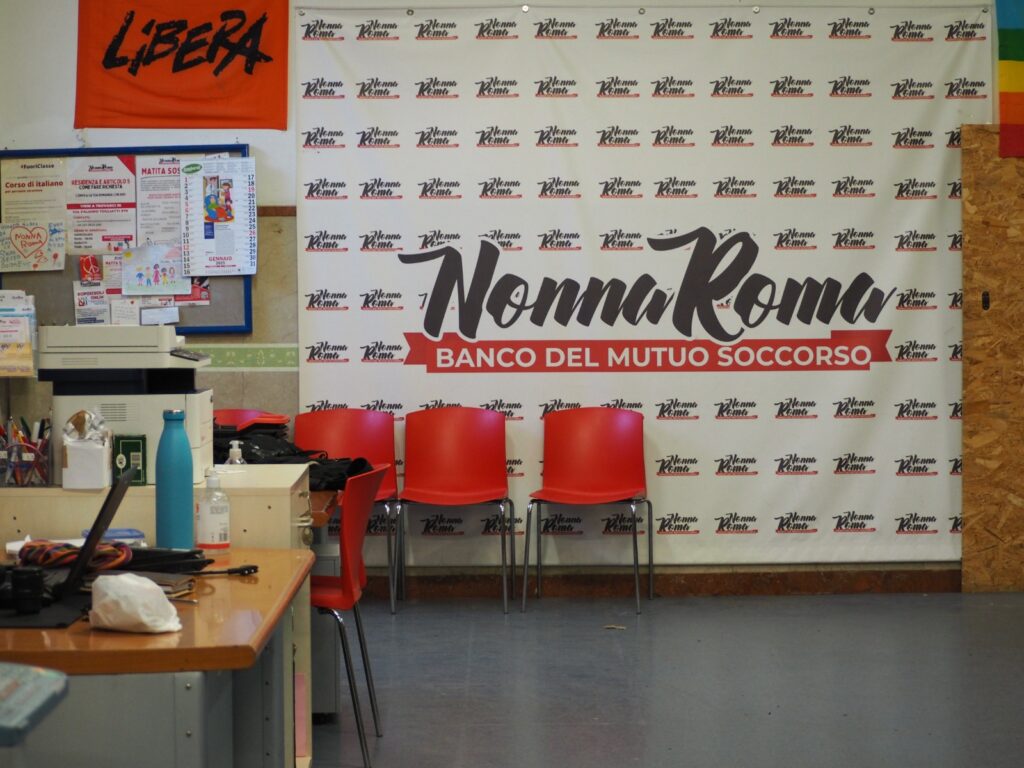In many European cities, rising rents, uncontrolled tourism and growing social inequalities have led to the emergence of collective forms of struggle and solidarity. Three such efforts, in Rome, Barcelona and Edinburgh, use different means to offer a concrete response to the housing crisis.
Mutual support in Rome
In Italy, one of the associations at the forefront of this struggle is Nonna Roma, founded in 2017. “The association began as a mutual aid bank,” explains Sara Fiordaliso, who works with Nonna Roma as a volunteer. “Food support is the first line of contact, and then there is a whole network of services built around people with the aim of ensuring that everyone is part of a single community.”
Among the association’s 200 or so volunteers are people who initially turned to Nonna Roma because they needed help. That need turned into awareness, and from there into commitment and political struggle.
Over the years, the association has also begun to address the housing crisis, moving from assistance to research and policy proposals. “There are about 18,500 families on the waiting list for social housing, and the wait to be allocated a home is several decades long,” says Sara, citing one of the many figures that illustrate the scale of the structural crisis.

In 2024, the survey Di casa a Roma (“At Home in Rome”) was published. This collective project on the housing crisis provided the basis for a campaign to tackle two major problems: the use of short-term rentals and the difficulty of accessing affordable rents. A year later, with the additional factor of the Jubilee, the situation is now critical.
“It is precisely due to the anticipation of this event that prices have skyrocketed, and rental properties in Rome are impossible to find,” explains Sara.
In peripheral neighbourhoods such as Pigneto, for example, there are thousands of short-term rental listings, but only a few dozen can be found on real estate portals. “We’ve seen listings for two-room flats for 2500 euro,” says Sara.
Although Rome is a large and complex city, it is part of a national context where most families own their homes or have a home at their disposal, free of charge or under usufruct. According to the association’s survey, figures from the Italian National Institute of Statistics (ISTAT) indicate that this is the case for about 80 percent of households in Italy, which is well above the European average. Tenants are therefore a very small and diverse group of individuals, competing in large cities for the few affordable rental opportunities, with dynamics that tend towards discrimination against those without a fixed-term contract, or racism.
In the Italian capital, however, something has changed over time, thanks in part to the network of associations brought together through the Social Forum Abitare, of which Nonna Roma is a member. One example is the housing helpdesk that has been set up in the Third Municipality in the northeast of the city, which the association helps to run. “We are currently building the mechanism that will lead to a housing mediation service,” says Sara.
The next challenge will be the implementation phase of the Housing Plan approved by the municipality, which could lead to the creation of a housing agency. With this in place, those who have difficulty accessing the rental market may be able to obtain a public guarantee from the administration.
Collective organisation in Barcelona
Among the European cities that have become protagonists in the struggle for housing rights is Barcelona. In Spain, rents have doubled over the last 10 years, and the rate of social housing ranks among the lowest in Europe (2.5%).
Among those highlighting these changes are organisations such as the Sindicat de Llogateres (”Union of Tenants”), which promotes the unionisation of tenants dealing with large real estate companies. The union has about 8,000 members, according to spokesperson Carme Arcarazo.
“About half of what a person earns is spent on rent,” says Carme, explaining why the union was founded in 2017. “Usually, the relationship between tenants and landlords is so unequal that negotiation is virtually impossible. Joining forces with other tenants rebalances the relationship, and then you can really negotiate.”
Putting the difficulties of individual tenants into a collective perspective is the key strategy that guides the activities of the Sindicat de Llogateres. Referring to the all too common situation where tenants face demands like “pay me double or leave” when their contract expires, Carme talks of “extortion”.
When someone contacts the union with such problems, “the first step is to check the land registry to see who owns the house and how many other properties the owner has. Then we knock on the doors of these other properties to talk to the tenants and see if they have the same problem.”
By mobilising people with similar problems, the aim is to achieve collective bargaining.
When this is not enough, other avenues are explored. This was the case with the rent strike launched in late 2024, following in the footsteps of the historic strike that took place in 1931. “I think there is a lot of support for the strike. I mean, it’s absurd that there is so little social housing, and it’s absurd that what little there is is being privatised. What’s more, we’re up against the biggest company in the sector.”
But the effort is also educational. “There’s a lot of education to be done”, Carme says, “but that’s normal, isn’t it? People are scared. There’s no culture of rent strikes, but I think everyone is aware of the right to strike in the world of work, and that’s because someone started doing it when it wasn’t legal.”
In addition to fighting for better conditions and changing laws, there is a cultural paradigm that has to be revolutionised, starting with the right to housing. “We don’t want to be a union of activists, of hyper-politicised people,” says Carme. The underlying idea is to overcome the fictitious division between ordinary citizens on the one hand and committed “activists” on the other. Class issues and the housing crisis affect both groups equally.
Rights and communities in Scotland
In 2024, the United Kingdom scored dramatic record: according to the OECD, the UK has the highest rate of homelessness among high-income countries. Scotland is one of the areas most affected by the housing crisis. In the Edinburgh region, there has been an average increase of 94% in rents for one-bedroom flats over the last decade.
It is in this context that Living Rent operates, combining unionisation to protect tenants via community-building, according to the grassroots logic of the ACORN model, which is based on local, democratic, member-based organisations that operate like a trade union.
Cameron Scally is chair of Living Rent Edinburgh’s branch in Leith, the city’s port area. He joined the union in 2020 during the pandemic, after a period of unemployment and difficulty paying his rent. “Edinburgh is primarily a university city, so much of the recent development has been around student accommodation,” he explains.

Here too, another factor affecting housing policy is tourism, particularly in the summer when events such as the Fringe drive the industry. “We are facing massive hotel development, and especially the conversion of existing housing into short-term rentals for well-known online rental sites.”
The situation is all too common, and it has recently led Edinburgh to introduce a tourist tax, thanks to a national law passed by the Scottish Parliament. “We have made some progress in this regard thanks to city-wide campaigns and national organisation,” says Cameron. “It’s not just about preventing tourists from coming, but about ensuring that tourism money stays in the city.”
Through consultations prior to the adoption of the tax, Living Rent managed to ensure that the proceeds would be used to support social housing, affordable rents and public spaces. One of the contradictions of the combined economic and housing crises is that in cities that depend on tourism, such as Edinburgh, workers in the tourism sector cannot afford the increasingly high rents.
According to Cameron, one of Living Rent’s strengths is its ability to make consultations accessible on both the local or national levels. “When the Scottish National Party and the Greens were in government together, they held a consultation to define the future of their housing policy for the next two years,” he says.
Consultations are communicated directly to industry associations and rental agencies, but certainly not to individual tenants. “For this reason,” Cameron continues, “Living Rent got together and drafted our response, then we took to the streets and asked people to support it. We basically turned it into a public opportunity to collect signatures and engage the community.” The result was that a technical and complex procedure became “much more accessible.”
👉 This article on Valigia Blu
In partnership with Display Europe, cofunded by the European Union. Views and opinions expressed are however those of the author(s) only and do not necessarily reflect those of the European Union or the Directorate‑General for Communications Networks, Content and Technology. Neither the European Union nor the granting authority can be held responsible for them.

Do you like our work?
Help multilingual European journalism to thrive, without ads or paywalls. Your one-off or regular support will keep our newsroom independent. Thank you!
















